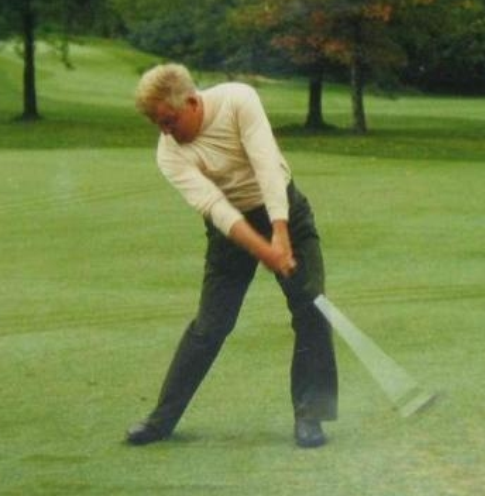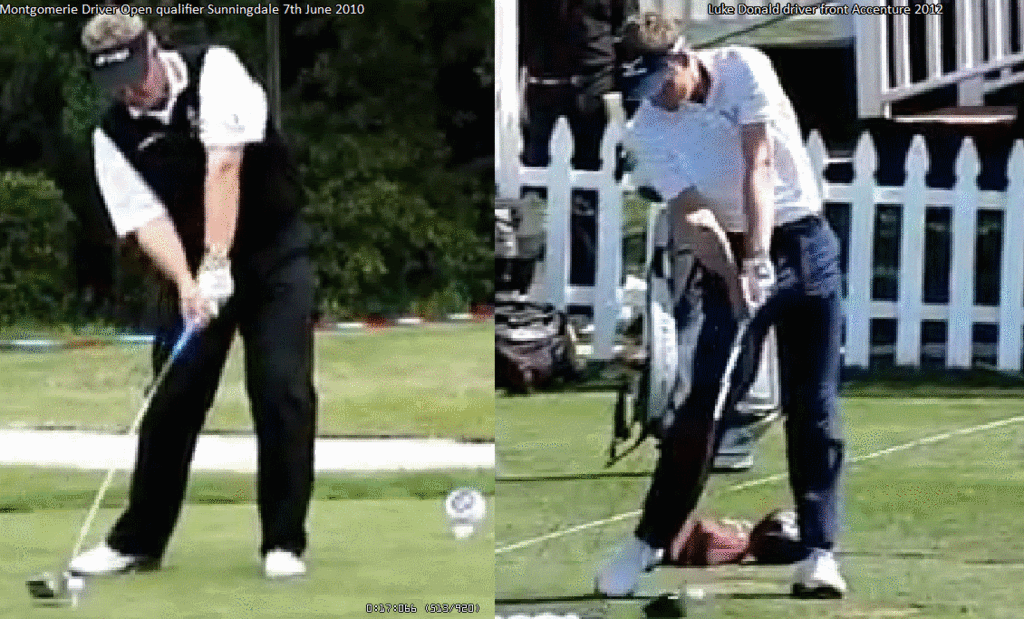Post by Richie3Jack on Jan 6, 2014 9:39:18 GMT -5
Colin Montgomerie will probably become a ‘forgotten ballstriker’ as his career really tailed off at the end. I have written about this in the past as to Monty’s game falling off while Kenny Perry’s game getting stronger as they both got older. And Perry is 3 years older than Monty.
My belief is that the club design and the course design had a lot to do with Monty’s decline and Perry’s rise. Perry is a unique golfer to watch because he hits a high draw with everything, but his driver has less curve from an angle perspective than his 9-iron. He REALLY bends the 9-iron. I believe that this is due to Perry hitting well up on the driver to the point where his path becomes less inside-to-out because he is hitting more up on the ball. Compare that with hitting down on a 9-iron, the path goes more inside-to-out and bends quite a bit.
I believe Monty was the direct opposite. He was known for hitting a very low cut. I’ve debated this with some people in the past, but if you watch the highlight video of the 1992 US Open at Pebble Beach (Tom Kite won), Monty does an interview talking about how low he hits it and how much it fades and how friends of his on Tour can’t believe how low and how much he can fade the ball. It’s no big surprise that he wasn’t very effective at Augusta.
To me, with the older metal drivers and the balata balls, hitting down on the ball a lot could work because of the smaller driver heads and the spinnier golf balls. Hitting up could work as well, but I have tried to hit up on persimmon and it is not easy to do. And there is one thing fairly clear about today’s courses, they generally favor hitting the ball higher. I believe that today’s courses are filled with more forced carries and Max Height on the shot becomes increasingly important. So for Perry, the equipment and course design started to fit right into his swing while it worked right against Monty’s swing.
The big thing Monty was known for was his iron play. Man, was he deadly with his irons in the Ryder Cup. He made Ian Poulter look like a chump when it came to competitiveness in the Ryder Cup. He was really that freaking good. I know he got a lot flak from American crowds, particularly at the 1999 Ryder Cup. If it is any consolation, there was a lot of that being done out of respect for his ability because if planet Earth had to play a group of invading, golf playing aliens for world domination, the American golf crowd would have demanded Monty be on the team. And I’m sure him and Seve would have gouged the aliens’ hearts out, stomped on them and giggled while the planet Earth continued its domination of the entire galaxy.

From my research on statistics and the game, it’s fairly obvious that those that hit down on the ball quite a bit tend to be better iron players than drivers of the ball. Of course, this is part of the reason why I got into doing statistical research on the game. For years I had played with very good golfers like Jason Gore and Tom Scherrer, both Tour winners, and saw them hit a lot of GIR and seeing that some high GIR players hit their driver well and their irons not nearly as well and vice versa.
I think it is pretty obvious that Monty hit down on the ball quite a bit. When we look at the DTL view at p5.5, the shaft plane is fairly steep. He also exits a bit left and then at the finish he gets quite a bit of extension. This would lead me to believe he hits down on it quite a bit and then in order to shallow out the attack angle a little better (it is still steep) he tries to get into extension to help with that.
What is also interesting is that he does maintain a centered pivot with a very steady head in the backswing. But, from the DTL view his hip slant is minimal, his rear knee still has a lot of flex to it and his shoulder turn is fairly flat. This will create a very armsy backswing because the body stops rotating at about p3 and he still has to complete his backswing so his arms do the rest of the work. And for the average golfer, they would likely come over the top and hit wipes. Monty is not over the top, but for a Tour pro his shaft plane is fairly steep. And again, he was known for hitting low-cuts.
I think his swing mostly revolved around his ability to tilt the spine towards the target and extend it on the backswing. That kept his head steady and allowed him to at least have a chance to make the compensations necessary on the downswing. I think his shaft plane was steep due to the left arm jutting out, but since the shaft plane was still pointing at the baseline, he could still hit quality golf shots. I also like the extension into the finish.
I think what the average golfer could probably learn here is that if you have a reasonably effective golf shot that you can repeat a lot, stick with it even if it doesn’t look pretty. The game of golf has been filled with golfers with ugly games and pretty scorecards. As golf instructor Sara Dickson once said about top-tier players; all of them have talent, those that trust their talent are the ones that tend to succeed.
3JACK
My belief is that the club design and the course design had a lot to do with Monty’s decline and Perry’s rise. Perry is a unique golfer to watch because he hits a high draw with everything, but his driver has less curve from an angle perspective than his 9-iron. He REALLY bends the 9-iron. I believe that this is due to Perry hitting well up on the driver to the point where his path becomes less inside-to-out because he is hitting more up on the ball. Compare that with hitting down on a 9-iron, the path goes more inside-to-out and bends quite a bit.
I believe Monty was the direct opposite. He was known for hitting a very low cut. I’ve debated this with some people in the past, but if you watch the highlight video of the 1992 US Open at Pebble Beach (Tom Kite won), Monty does an interview talking about how low he hits it and how much it fades and how friends of his on Tour can’t believe how low and how much he can fade the ball. It’s no big surprise that he wasn’t very effective at Augusta.
To me, with the older metal drivers and the balata balls, hitting down on the ball a lot could work because of the smaller driver heads and the spinnier golf balls. Hitting up could work as well, but I have tried to hit up on persimmon and it is not easy to do. And there is one thing fairly clear about today’s courses, they generally favor hitting the ball higher. I believe that today’s courses are filled with more forced carries and Max Height on the shot becomes increasingly important. So for Perry, the equipment and course design started to fit right into his swing while it worked right against Monty’s swing.
The big thing Monty was known for was his iron play. Man, was he deadly with his irons in the Ryder Cup. He made Ian Poulter look like a chump when it came to competitiveness in the Ryder Cup. He was really that freaking good. I know he got a lot flak from American crowds, particularly at the 1999 Ryder Cup. If it is any consolation, there was a lot of that being done out of respect for his ability because if planet Earth had to play a group of invading, golf playing aliens for world domination, the American golf crowd would have demanded Monty be on the team. And I’m sure him and Seve would have gouged the aliens’ hearts out, stomped on them and giggled while the planet Earth continued its domination of the entire galaxy.

From my research on statistics and the game, it’s fairly obvious that those that hit down on the ball quite a bit tend to be better iron players than drivers of the ball. Of course, this is part of the reason why I got into doing statistical research on the game. For years I had played with very good golfers like Jason Gore and Tom Scherrer, both Tour winners, and saw them hit a lot of GIR and seeing that some high GIR players hit their driver well and their irons not nearly as well and vice versa.
I think it is pretty obvious that Monty hit down on the ball quite a bit. When we look at the DTL view at p5.5, the shaft plane is fairly steep. He also exits a bit left and then at the finish he gets quite a bit of extension. This would lead me to believe he hits down on it quite a bit and then in order to shallow out the attack angle a little better (it is still steep) he tries to get into extension to help with that.
What is also interesting is that he does maintain a centered pivot with a very steady head in the backswing. But, from the DTL view his hip slant is minimal, his rear knee still has a lot of flex to it and his shoulder turn is fairly flat. This will create a very armsy backswing because the body stops rotating at about p3 and he still has to complete his backswing so his arms do the rest of the work. And for the average golfer, they would likely come over the top and hit wipes. Monty is not over the top, but for a Tour pro his shaft plane is fairly steep. And again, he was known for hitting low-cuts.
I think his swing mostly revolved around his ability to tilt the spine towards the target and extend it on the backswing. That kept his head steady and allowed him to at least have a chance to make the compensations necessary on the downswing. I think his shaft plane was steep due to the left arm jutting out, but since the shaft plane was still pointing at the baseline, he could still hit quality golf shots. I also like the extension into the finish.
I think what the average golfer could probably learn here is that if you have a reasonably effective golf shot that you can repeat a lot, stick with it even if it doesn’t look pretty. The game of golf has been filled with golfers with ugly games and pretty scorecards. As golf instructor Sara Dickson once said about top-tier players; all of them have talent, those that trust their talent are the ones that tend to succeed.
3JACK









 - not sure who really is a handle dragger). Good players have much faster left forearm supination than the speed of their right forearm pronation.
- not sure who really is a handle dragger). Good players have much faster left forearm supination than the speed of their right forearm pronation.